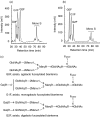Hypogalactosylation of serum IgG in patients with coeliac disease
- PMID: 12930370
- PMCID: PMC1808795
- DOI: 10.1046/j.1365-2249.2003.02220.x
Hypogalactosylation of serum IgG in patients with coeliac disease
Abstract
Coeliac disease (CD) is described as an autoimmune enteropathy associated with the presence of IgG and IgA antigliadin and antitransglutaminase autoantibodies. While of diagnostic significance, the role of these autoantibodies in the immunopathogenesis of CD is elucidated. An inappropriate T cell immune response to gluten is also involved in the pathogenesis of CD, as evidenced by autoantibody switching. The N-glycans released from serum IgG of CD patients and three groups of healthy controls, of differing age ranges, were analysed by NH2-high performance liquid chromatography (HPLC). The fucosylated biantennary N- glycans were the most abundant neutral oligosaccharides; in particular, the agalacto form (G0F) showed a mean value of 42% (s.d. +/- 7.4), 30% (s.d. +/- 5.9), 26% (s.d. +/- 4.2) and 35% (s.d. +/- 6.8) for CD patients, healthy children, healthy adults under 40 and healthy adults over 40 years old, respectively. The ratio of asialo agalacto fucosylated biantenna to asialo monogalacto fucosylated biantenna (G0F)/(G1F) for CD patients showed a significant increase compared to healthy children (P < 0.0002), healthy adults under 40 (P < 0.0002) and healthy adults over 40 years old (P < 0.01). Hypogalactosylation was more pronounced for CD patients than for the patients with other autoimmune diseases such as rheumatoid arthritis or psoriatic arthritis.
Figures



References
-
- Fassano A. Celiac disease: the past, the present, the future. Pediatrics. 2001;107:768–70. - PubMed
-
- Sollid LM. Molecular basis of coeliac disease. Annu Rev Immunol. 2000;18:53–81. - PubMed
-
- Sollid LM, Thorsby E. HLA susceptibility genes in coeliac disease: genetic mapping and role in pathogenesis. Gastroenterology. 1993;105:910–22. - PubMed
-
- Schuppan D, Hahn E. Celiac disease and its link to type 1 diabetes mellitus. J Pediatr Endocrinol Metab. 2001;14:1–9. - PubMed
MeSH terms
Substances
LinkOut - more resources
Full Text Sources
Medical
Miscellaneous

